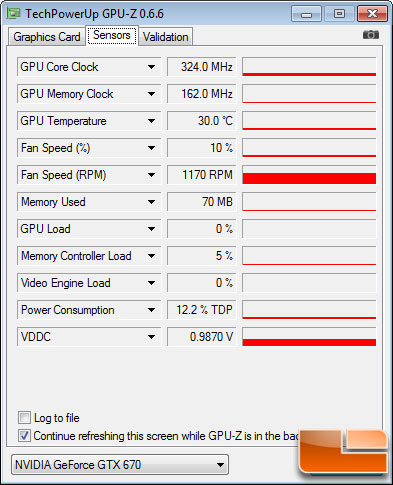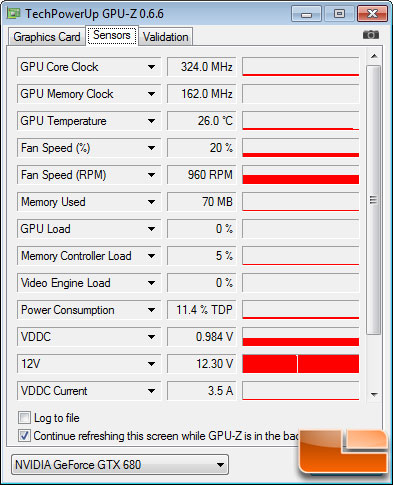ASUS GeForce GTX 680 & GTX 670 DirectCU II Top Edition Video Card Reviews
Temperature & Noise Testing
Temperatures are important to enthusiasts and gamers, so we took a bit of time and did some temperature testing on the cards with the ASUS DirectCU II GPU Cooler!
ASUS GeForce GTX 670 DirectCU II Top Idle:

The ASUS GeForce GTX 670 DirectCU II Top card had an idle temperature of 30.0C in a room that was 22.0C (72F). The dual fans were spinning at ~1200 RPM and was the card was fairly silent.
ASUS GeForce GTX 670 DirectCU II Top in Furmark:

With Furmark fired up and running at 1024×768 we saw the temperature reach 73C and level off there. Notice that the fan RPMs barely jumped up. At full load the fans were spinning around 1,680RPM, so the noise increase was minimal.
ASUS GeForce GTX 680 DirectCU II Top Idle:

The ASUS GeForce GTX 670 DirectCU II Top card had an idle temperature of 26.0C in a room that was 22.0C (72F). The dual fans were spinning at ~960 RPM and was the card was quiet.
ASUS GeForce GTX 680 DirectCU II Top in Furmark:

With Furmark fired up and running at 1024×768 we saw the temperature reach 67C and level off there. Notice that the fan RPMs barely jumped up. At full load the fans were spinning around 1,650RPM, so the noise increase was minimal.

The Sapphire Radeon HD 7970 Vapor-X might use the same cooler at the Sapphire Radeon HD 7950 Vapor-X, but it is clear that the 7970 GPU runs much hotter due to the extra cores and higher clock speeds. THe ASUS GeForce GTX 670 and GTX 680 both use DirectCU II GPU coolers, but they are very different. The ASUS GeForce GTX 680 Top uses five direct touch heatpipes and has larger fans and heatsinks to keep the temperatures down. The ASUS GeForce GTX 670 DirectCU II card has three direct touch heatpipes and smaller fans, which is the reason why we are seeing higher temps at both idle and load. There is a 9C difference between the GTX 670 and GTX 680 in games, so you can really see the benefits of the triple slot cooler on the GTX 680!
Sound Testing

We recently upgraded our sound meter to an Extech sound level meter with 1.5dB accuracy that meets Type 2 standards. This meter ranges from 35dB to 90dB on the low measurement range, which is perfect for us as our test room usually averages around 38dB. We measure the sound level two inches above the corner of the motherboard with ‘A’ frequency weighting. The microphone wind cover is used to make sure no wind is blowing across the microphone, which would seriously throw off the data.

The Sapphire HD 7970 and Radeon HD 7950 cards both use Vapor-X GPU coolers and they are great solutions that are rather quiet. We were shocked to see that the ASUS GeForce GTX670 and GTX680 DirectCU II GPU coolers performed quieter at both idle and load by a significant margin. If you are concerned with noise and temperatures, you can rest easy knowing that the ASUS DirectCU II GPU cooler remains one of the best cooling options out there for graphics cards! Many may think that companies just change the cooler to make their cards look different, but that is not the case here. ASUS has done a good job here with well built coolers that have innovative features like dust-proof fans!

Comments are closed.